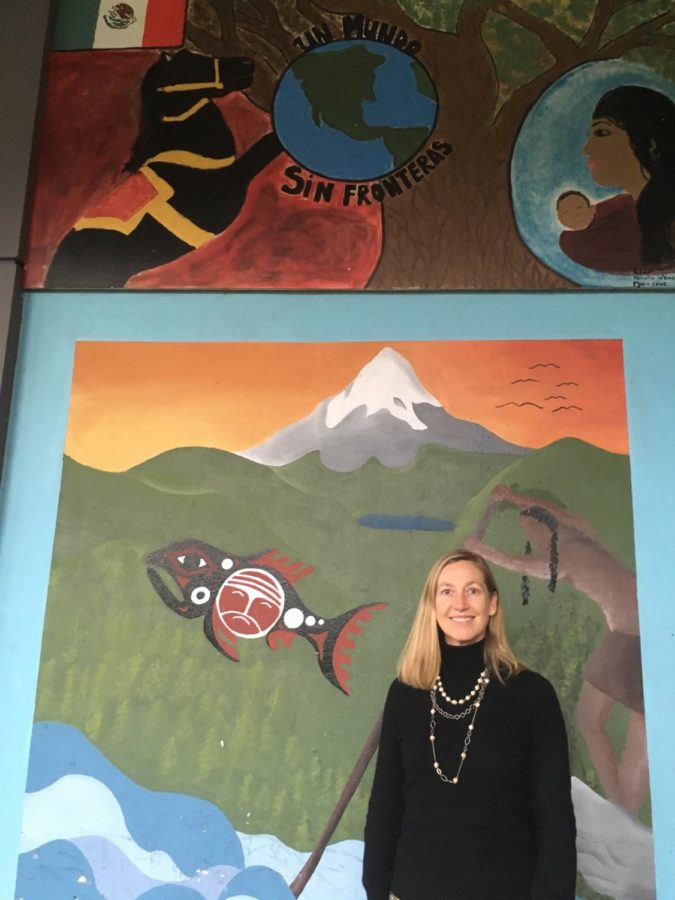Chapman pushes for peace center
Principal Peyton Chapman stands in front of a mural that illustrates Lincoln’s committment to a global education. Chapman would like this commitment to extend to the rest of the building in the rebuilt Lincoln.
Lincoln’s building is over 60 years old. Generation after generation has walked through the same halls, attended classes in the same rooms, and ate lunch upon those same floors.
However, come 2020, students and faculty alike are preparing to say goodbye to the historic high school building, and while the old walls will eventually come down, Lincoln’s spirit will remain in the new school.
With the creation of the new and improved facility, Principal Peyton Chapman hopes to highlight one aspect of the school’s spirit: a globally-focused education.
Chapman envisions an “Interactive Global Peace Center” to be included into the rebuilt school, possibly even in the main entrance, so that the moment people walk into Lincoln, they know that the school supports equality for all global citizens.
She had at first considered a center that would display work from IB Geography and Art students that highlights global issues, and acts as a restorative space to resolve conflict, inspire change, and promote acceptance. This would be in addition to the conflict mediation spaces, meditation and mindfulness rooms in the new building. It would host events like the “Culture Nights,” and “Courageous Conversations.”
However, Chapman’s initial idea has evolved, expanding so that the reconstruction of the entire building focuses on peace and justice as a whole, and the theme of global inclusivity reigns throughout the building.
She said that her team, including members of the Rotary Club, the Cutter Foundation, Portland State University, Physicians for Social Responsibility, Mercy Corps, current students and alumni have suggested that “since you’re building a whole new school, why does it have to be a peace center? Or a room? Why don’t you have a whole school reflect those values of peace and justice?”
Chapmans revised plans to still include a meditation room, and a conflict mediation center, only now she hopes the new plan will provide the room necessary to further represent the ideals Lincoln upholds as an IB school. She hopes for a circular auditorium-style classroom, or “model UN room,” where Lincoln can host Constitution Team debates, mock trial, and history bowls.
Further, Chapman suggests that each level of the seven-story new Lincoln represent one of seven tenets of peace.
However, some students wonder whether this peace center would mean a new era for Lincoln, or just a new remodel.
Senior Ezra Berg has no direct reservations to the idea of a peace center, but states that “we should lead by example not by titles.” He hopes that the new peace center will act as a place of action, a chance for Lincoln to lead by example in being an all-inclusive space, rather than a title to showcase global peace without actually striving for it.
Some students are concerned that money will be redistributed for the peace and justice project instead of fixing basic building repairs.
Junior Julian Stark believes that our first priority should be to obtain “the basic necessities we need as a high school.” He states that if, “we’re just spending all [this money] on these new ideas…than it’s a waste of money.”
Berg also believes that the new peace center should “take a backseat to more academic classes such as ceramics and art.”
Chapman reassures students that the project shouldn’t necessarily cost more as it is “more about where do we put the yoga studio, [and] what quotes do we want on the wall,” since the theme of peace and justice will be woven into the very construction of the building itself.
Chapman believes that incorporating aspects of peace and justice throughout the school is a necessity because, “learning doesn’t just happen in the classroom and stop,” which is why she intends to find a way to “bring it out into the hallways as well.”
While Chapman states they are, “still in the ide and brainstorming phase,” she would, “personally love to see this happen.”
Members of the student body agree with her.
Junior Matthew Johnson believes that, “Now more than ever, when you have country divided down party-lines…it’s important to create a space where people feel as though they can safely share their ideological differences without being ridiculed or condemned.”

